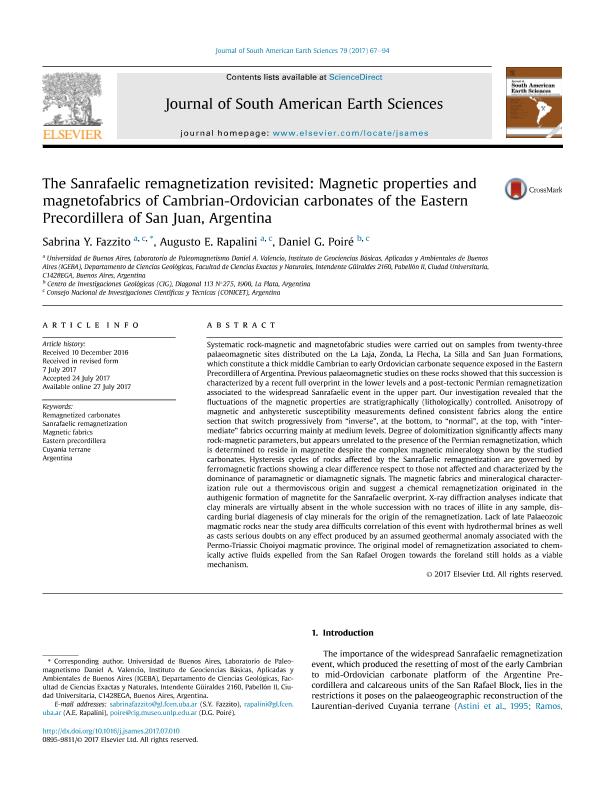Mostrar el registro sencillo del ítem
dc.contributor.author
Fazzito, Sabrina Yesica

dc.contributor.author
Rapalini, Augusto Ernesto

dc.contributor.author
Poire, Daniel Gustavo

dc.date.available
2018-11-26T17:45:46Z
dc.date.issued
2017-11
dc.identifier.citation
Fazzito, Sabrina Yesica; Rapalini, Augusto Ernesto; Poire, Daniel Gustavo; The Sanrafaelic remagnetization revisited: Magnetic properties and magnetofabrics of Cambrian-Ordovician carbonates of the Eastern Precordillera of San Juan, Argentina; Pergamon-Elsevier Science Ltd; Journal of South American Earth Sciences; 79; 11-2017; 67-94
dc.identifier.issn
0895-9811
dc.identifier.uri
http://hdl.handle.net/11336/65187
dc.description.abstract
Systematic rock-magnetic and magnetofabric studies were carried out on samples from twenty-three palaeomagnetic sites distributed on the La Laja, Zonda, La Flecha, La Silla and San Juan Formations, which constitute a thick middle Cambrian to early Ordovician carbonate sequence exposed in the Eastern Precordillera of Argentina. Previous palaeomagnetic studies on these rocks showed that this succession is characterized by a recent full overprint in the lower levels and a post-tectonic Permian remagnetization associated to the widespread Sanrafaelic event in the upper part. Our investigation revealed that the fluctuations of the magnetic properties are stratigraphically (lithologically) controlled. Anisotropy of magnetic and anhysteretic susceptibility measurements defined consistent fabrics along the entire section that switch progressively from “inverse”, at the bottom, to “normal”, at the top, with “intermediate” fabrics occurring mainly at medium levels. Degree of dolomitization significantly affects many rock-magnetic parameters, but appears unrelated to the presence of the Permian remagnetization, which is determined to reside in magnetite despite the complex magnetic mineralogy shown by the studied carbonates. Hysteresis cycles of rocks affected by the Sanrafaelic remagnetization are governed by ferromagnetic fractions showing a clear difference respect to those not affected and characterized by the dominance of paramagnetic or diamagnetic signals. The magnetic fabrics and mineralogical characterization rule out a thermoviscous origin and suggest a chemical remagnetization originated in the authigenic formation of magnetite for the Sanrafaelic overprint. X-ray diffraction analyses indicate that clay minerals are virtually absent in the whole succession with no traces of illite in any sample, discarding burial diagenesis of clay minerals for the origin of the remagnetization. Lack of late Palaeozoic magmatic rocks near the study area difficults correlation of this event with hydrothermal brines as well as casts serious doubts on any effect produced by an assumed geothermal anomaly associated with the Permo-Triassic Choiyoi magmatic province. The original model of remagnetization associated to chemically active fluids expelled from the San Rafael Orogen towards the foreland still holds as a viable mechanism.
dc.format
application/pdf
dc.language.iso
eng
dc.publisher
Pergamon-Elsevier Science Ltd

dc.rights
info:eu-repo/semantics/openAccess
dc.rights.uri
https://creativecommons.org/licenses/by-nc-nd/2.5/ar/
dc.subject
Argentina
dc.subject
Cuyania Terrane
dc.subject
Eastern Precordillera
dc.subject
Magnetic Fabrics
dc.subject
Remagnetized Carbonates
dc.subject
Sanrafaelic Remagnetization
dc.subject.classification
Otras Ciencias de la Tierra y relacionadas con el Medio Ambiente

dc.subject.classification
Ciencias de la Tierra y relacionadas con el Medio Ambiente

dc.subject.classification
CIENCIAS NATURALES Y EXACTAS

dc.title
The Sanrafaelic remagnetization revisited: Magnetic properties and magnetofabrics of Cambrian-Ordovician carbonates of the Eastern Precordillera of San Juan, Argentina
dc.type
info:eu-repo/semantics/article
dc.type
info:ar-repo/semantics/artículo
dc.type
info:eu-repo/semantics/publishedVersion
dc.date.updated
2018-10-23T21:19:10Z
dc.journal.volume
79
dc.journal.pagination
67-94
dc.journal.pais
Estados Unidos

dc.description.fil
Fil: Fazzito, Sabrina Yesica. Consejo Nacional de Investigaciones Científicas y Técnicas. Oficina de Coordinación Administrativa Ciudad Universitaria. Instituto de Geociencias Básicas, Aplicadas y Ambientales de Buenos Aires. Universidad de Buenos Aires. Facultad de Ciencias Exactas y Naturales. Instituto de Geociencias Básicas, Aplicadas y Ambientales de Buenos Aires; Argentina
dc.description.fil
Fil: Rapalini, Augusto Ernesto. Consejo Nacional de Investigaciones Científicas y Técnicas. Oficina de Coordinación Administrativa Ciudad Universitaria. Instituto de Geociencias Básicas, Aplicadas y Ambientales de Buenos Aires. Universidad de Buenos Aires. Facultad de Ciencias Exactas y Naturales. Instituto de Geociencias Básicas, Aplicadas y Ambientales de Buenos Aires; Argentina
dc.description.fil
Fil: Poire, Daniel Gustavo. Consejo Nacional de Investigaciones Científicas y Técnicas. Centro Científico Tecnológico Conicet - La Plata. Centro de Investigaciones Geológicas. Universidad Nacional de La Plata. Facultad de Ciencias Naturales y Museo. Centro de Investigaciones Geológicas; Argentina
dc.journal.title
Journal of South American Earth Sciences

dc.relation.alternativeid
info:eu-repo/semantics/altIdentifier/url/http://www.sciencedirect.com/science/article/pii/S089598111630308X
dc.relation.alternativeid
info:eu-repo/semantics/altIdentifier/doi/http://dx.doi.org/10.1016/j.jsames.2017.07.010
Archivos asociados
